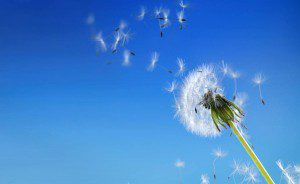
With the first week of Spring marking National Asthma Week (September 1 – 7), the National Asthma Council Australia says that the week is a timely reminder for people with asthma or allergies to take extra care.
Pollens from grasses, weeds or trees can trigger allergies like asthma and hay fever, causing a variety of symptoms to flare up.
According to the Bureau of Meteorology, this past autumn was wetter than normal and this winter has seen drier-than-average conditions. That makes the coming pollen season a mixed bag across Australia. An El Nino forecast for 2015-2016 could shorten the pollen season in some parts of Australia but elsewhere allergy sufferers may be in for a tough few months ahead.
According to Associate Professor Ed Newbigin from the University or Melbourne and coordinator of the Melbourne pollen count, the start of the hay fever season varies according to location and from one year to another.
“Typically European trees like birch and elm pollinate at the end of winter and beginning of spring and grasses start pollinating a month or two later. But with climate change causing milder winters in southern Australia and wet season changes in the north we expect to see differences in when plants flower as well as where plants grow.
“This year we are expecting bad hay fever seasons for Canberra and Sydney but allergy sufferers in Melbourne should have an easier time of it.”
As well as affecting the length and duration of the pollen season, climate change has the potential to impact people with asthma and allergies by causing more extreme weather events like thunderstorms.
Thunderstorms can trigger asthma flare-ups as stormy winds and moisture can cause the pollen to rupture into smaller particles, which can be inhaled deeper into the lungs.
The situation is exacerbated when grass pollen levels are high just before a thunderstorm.
National Asthma Council Australia Spokesperson Associate Professor Sheryl van Nunen, from the Department of Clinical Immunology and Allergy, Royal North Shore Hospital in Sydney, said that the best way to manage an allergy is to avoid triggers.
[social_quote duplicate=”no” align=”default”]“The best way to treat allergy and asthma is to prevent it occurring. Have your lungs checked by your GP to make sure you’re as healthy as possible, and let them know if you think pollen, thunderstorms or weather changes affect your asthma.[/social_quote]
“Use your preventer medication every day, if prescribed, even when you are feeling well, and ensure you have an up-to-date written asthma action plan from your GP so you know what to do if your asthma flares up.
“Apart from the misery caused, be aware that the worse your hay fever is, the worse your asthma will be and the more likely you are to need hospitalisation for asthma.
“Moreover, house dust mite is more prevalent at the change of seasons and many people spring clean, so the 74 percent of Australian hay fever sufferers who are house dust mite allergic will have their house dust mite allergy aggravated then too.”
Sydney pollen monitoring started yesterday (September 1).
Allergen avoidance doesn’t cure asthma, but by reducing your exposure to allergen triggers you may improve your asthma control and help make symptoms easier to manage.
Top Tips to Reduce Pollen Exposure from National Asthma Council Australia
Try to stay indoors during and after thunderstorms.
Keep car windows closed and use recirculated air when pollen levels are high. Car air filters will also help.
Consider planting a low allergen garden around the home.
Check plants in your garden for those that could be aggravating asthma/allergies.
Wear glasses to keep pollen out of your eyes.
Avoid mowing lawns or wear a mask if it is unavoidable.
For more information and tips visit the National Asthma Council Australia website.
